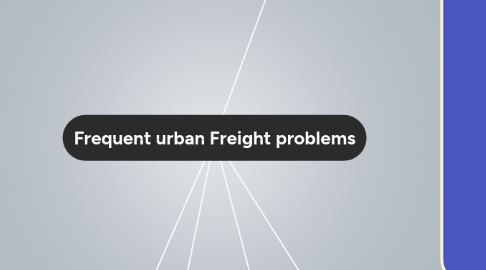
1. Limitation
1.1. Limited infrastructure
1.1.1. Lack of financial ressources
1.1.2. Lack of suitable logistics areas
1.2. Legislation / restrictions
1.2.1. Limited freedom for decision making
1.2.1.1. EU-law
1.2.1.2. German law
1.2.1.3. Federal stat law
1.2.1.4. City law
1.2.2. Conflict of objectives - residents vs. economy
1.2.2.1. No (affordable) logistic areas available - Deopt structures located in urban areas
1.2.2.2. Small delivery vans - increase number of trips
1.2.2.3. Speed limit - increase travel times
1.2.2.4. Access restrictions - increace delivery distance/time
1.2.2.5. Prioritisation of public transports vs. logistics
1.2.2.6. etc.
2. Traffic
2.1. Traffic congestion
2.1.1. Disruption
2.1.1.1. Predictable
2.1.1.1.1. Construction zones
2.1.1.1.2. Events
2.1.1.1.3. Holidays
2.1.1.1.4. etc.
2.1.1.2. Unpredictable
2.1.1.2.1. Accidents
2.1.1.2.2. Weather
2.1.1.2.3. etc.
2.1.2. Insufficient road infrastructure
2.1.2.1. Historic city center
2.1.2.2. Low clearance height
2.1.2.3. Narrow streets
2.1.2.4. etc.
2.1.3. Insufficient traffic management
2.1.3.1. Traffic light controll
2.1.3.2. Individual speed restriction
2.1.3.3. etc.
2.2. Emission
2.2.1. Noise emissions - driving noise
2.2.2. Exhaust emissions
2.2.2.1. CO² emissionen
2.2.2.2. Praticulate matter
2.2.2.3. etc.
2.3. Safety issues
2.3.1. Intimidation of road users due to goods vehicles
2.3.1.1. Cyclists
2.3.1.2. Pedestrians
2.3.1.3. Motorcyclists
2.3.1.4. etc.
2.3.2. Increased risk of accidents
2.4. Damage of road surface and infrastructure
3. Customer / reciver
3.1. Order restrictions
3.1.1. Time restrictions
3.1.1.1. Delivery time
3.1.1.1.1. Arrive within designated times
3.1.1.1.2. Exceed time frame - contract penalty
3.1.1.2. Pickup time
3.1.1.3. Transport time
3.1.1.4. Asset restriction
3.1.2. Acting responsibly (good customer relation) - conflict of objectives
3.1.2.1. Illegal parking
3.1.2.2. Conflicts with other road users during delivery operations
3.1.2.2.1. Loading
3.1.2.2.2. Unloading
3.1.2.3. Noise emissions - transshipment noise
3.2. B2B
3.2.1. Waiting time during deliveries & pick ups
3.2.2. Rising requirments of customer/reciver
3.2.2.1. Ongoinig cost pressure by customers
3.2.2.2. Changing ordering behavior - increasing number of shipments
3.2.2.2.1. Multiple daily deliveries/collections
3.2.2.2.2. Additional trips - including overheads
3.2.2.2.3. Inefficient trip planning
3.2.2.2.4. Unused benefits of bundling effects - Lack of co-operation & co-ordination - B2B
3.2.2.2.5. Lack of payload
3.2.2.3. Ecofriendly deliverys are required
3.2.3. Rising service expectations
3.2.3.1. Punctually
3.2.3.2. Undamged
3.2.3.3. etc.
3.2.4. Lack of suitable infrastructure
3.2.4.1. Ramps
3.2.4.1.1. Delayed loading / unloading process
3.2.4.1.2. Incorrect handling
3.2.4.2. Areas for loading & unloading
3.2.4.2.1. Lack of unloading space
3.2.4.2.2. Handling problems
3.2.4.3. Missing/undersized parking space
3.2.4.3.1. Double-park
3.2.4.3.2. Fines
3.2.4.3.3. Delays
3.2.5. Problems in finding the receiver
3.2.5.1. Within pedestrian zones
3.2.5.2. Within shopping centers
3.3. B2C
3.3.1. Ongoinig cost pressure by customers
3.3.2. Rising service expectations
3.3.2.1. Punctualiy
3.3.2.2. Undamged
3.3.2.3. etc.
3.3.3. Changing ordering behavior - increasing number of shipments
3.3.3.1. Multiple daily deliveries/collections
3.3.3.2. Additional trips - including overheads
3.3.3.2.1. Setup time
3.3.3.2.2. Journey
3.3.3.2.3. City toll
3.3.3.2.4. etc.
3.3.3.3. Complex tour planning
3.3.3.4. Unused benefits of bundling effects - Lack of co-operation & co-ordination - B2C
3.3.4. Ecofriendly deliverys are required
3.3.5. Problems in finding the receiver
3.3.5.1. Within pedestrian zones
3.3.5.2. Within shopping centers
3.3.6. Missing/undersized parking space
3.3.6.1. Double-park
3.3.6.2. Fines
3.3.6.3. Delays
4. Limitation
4.1. Legislation / restrictions
4.1.1. Speed limit
4.1.2. Parking
4.1.2.1. Fines
4.1.2.2. Time slot
4.1.3. Restriction on the use of reserved lanes
4.1.4. Access restrictions
4.1.4.1. Acces restrictions according to varios ctireria
4.1.4.1.1. Size
4.1.4.1.2. Weight
4.1.4.1.3. Time
4.1.4.2. Total access restiction
4.1.4.2.1. Pedestrian zone
4.1.4.2.2. Historic centers
4.1.4.2.3. etc.
4.2. Technical
4.2.1. Missing map Data & Content
4.2.1.1. Road network / Routing information
4.2.1.1.1. Available/unavailable roads
4.2.1.1.2. Width, height. weight,... restictions
4.2.1.1.3. Environmental zones
4.2.1.1.4. Noise prevention zones
4.2.1.1.5. etc.
4.2.1.2. Traffic state & prediction
4.2.1.2.1. Current traffic situation
4.2.1.2.2. Traffic prediction
4.2.2. Environmentally fiendly vehicles to satisfy restrictions
4.2.2.1. High purchcase cost
4.2.2.2. Small vehicle range
4.2.2.3. Load capacity
4.2.2.4. etc.
5. Traffic
5.1. Migration of companies - lack of capacity on highway network
5.2. Additonal Costs
5.2.1. Delay
5.2.1.1. More vehicles/drivers inserted to buffer traffic related delays
5.2.1.2. Contract penalty
5.2.2. Incresed consumption
5.2.2.1. Low travel speed
5.2.2.2. High downtimes
5.2.2.3. Stop-start traffic
5.2.2.4. etc.
